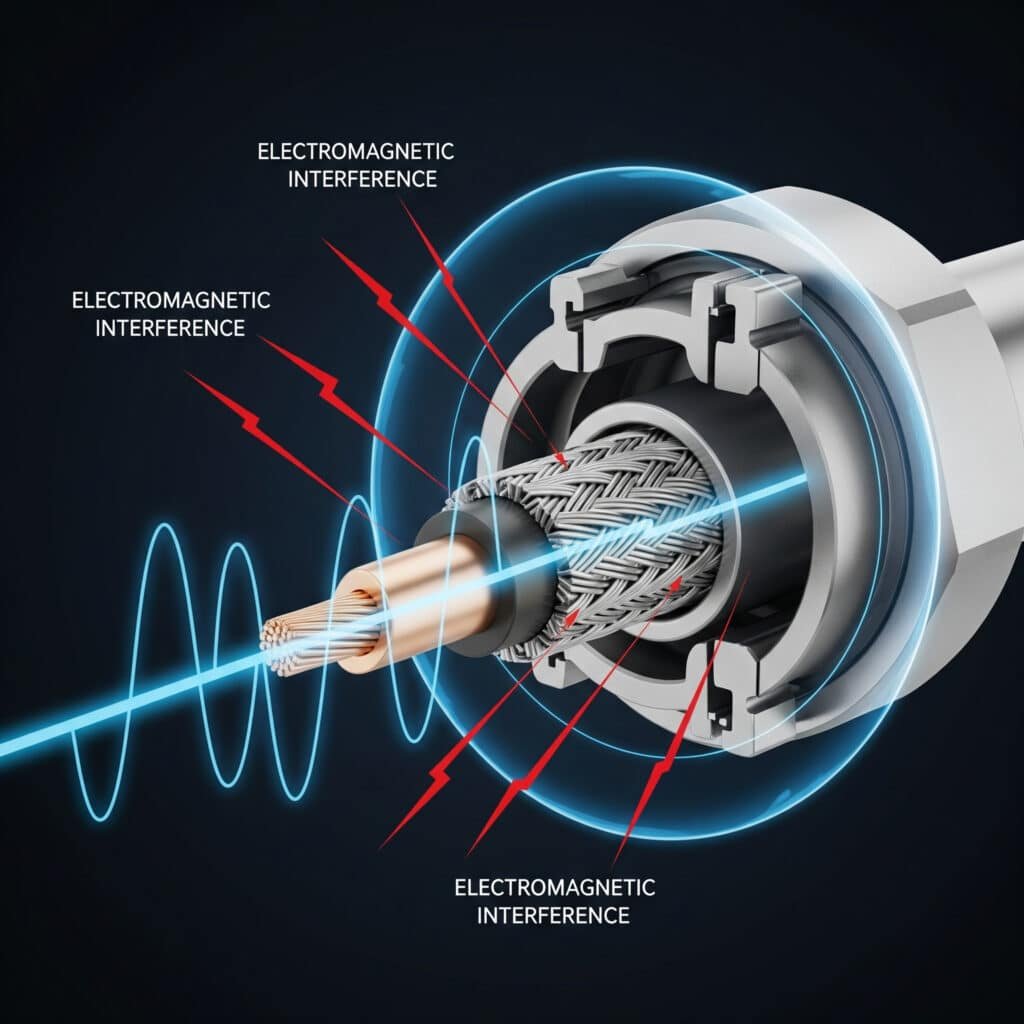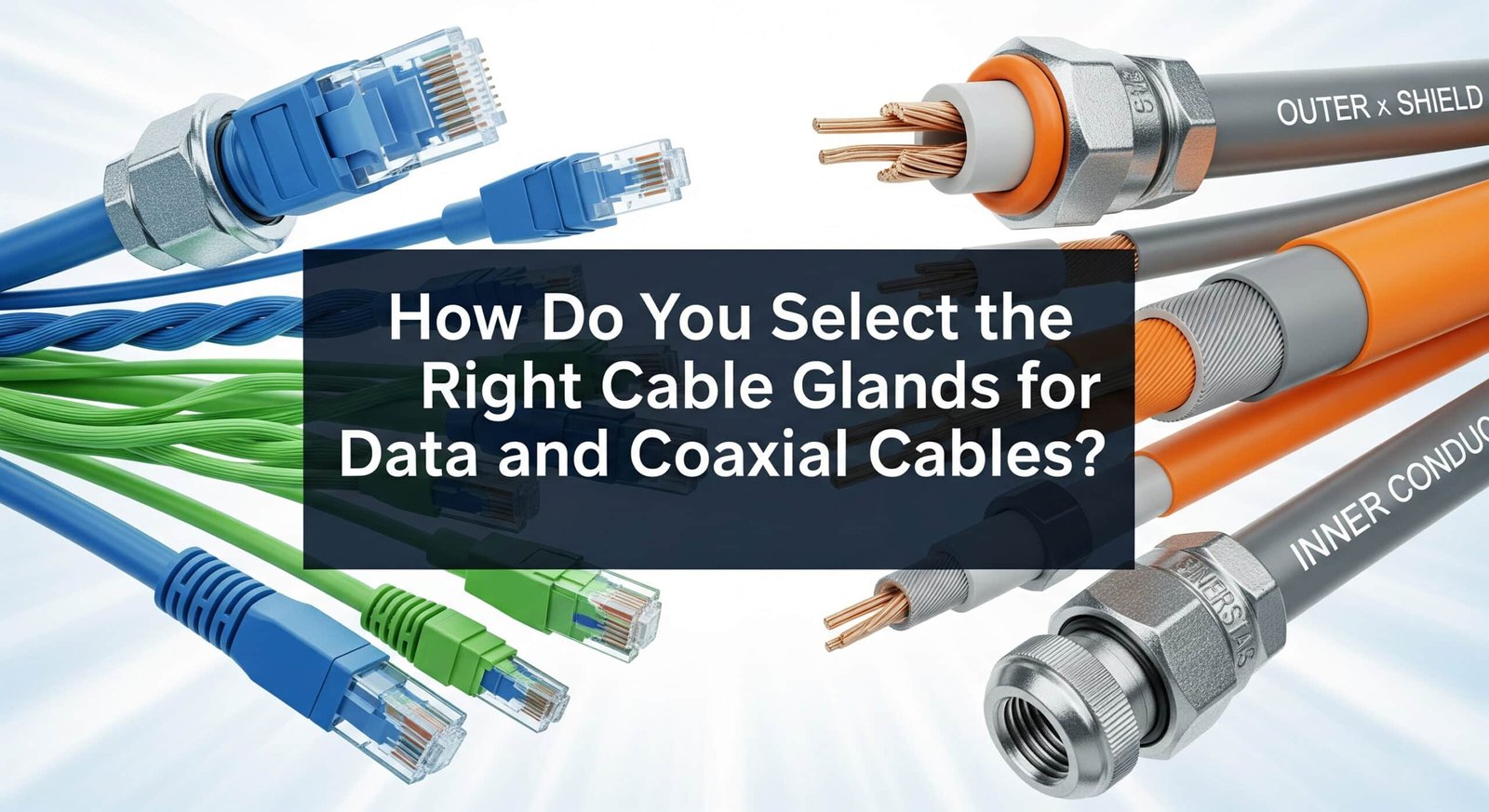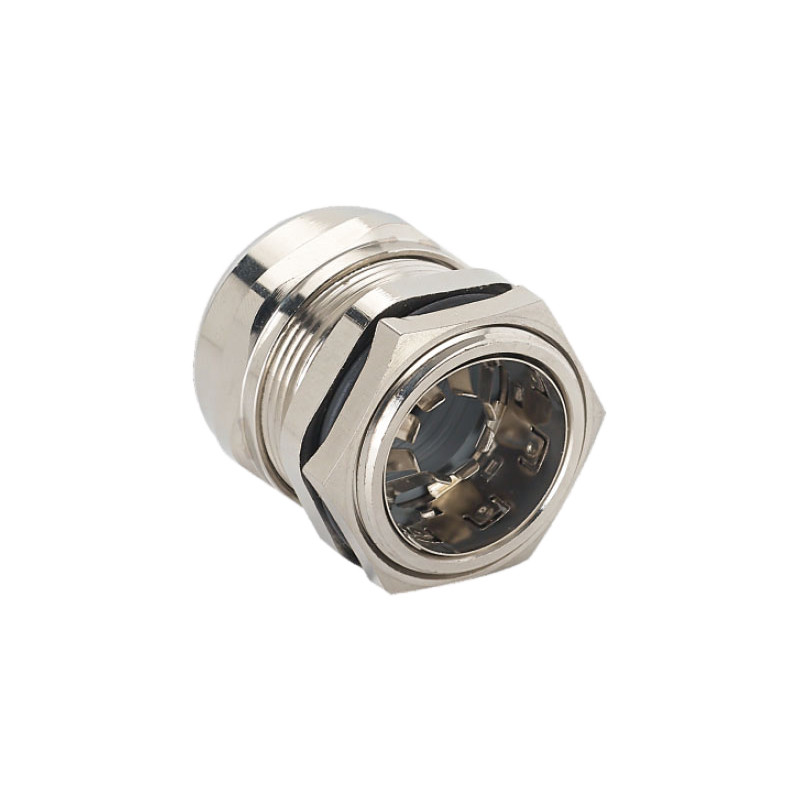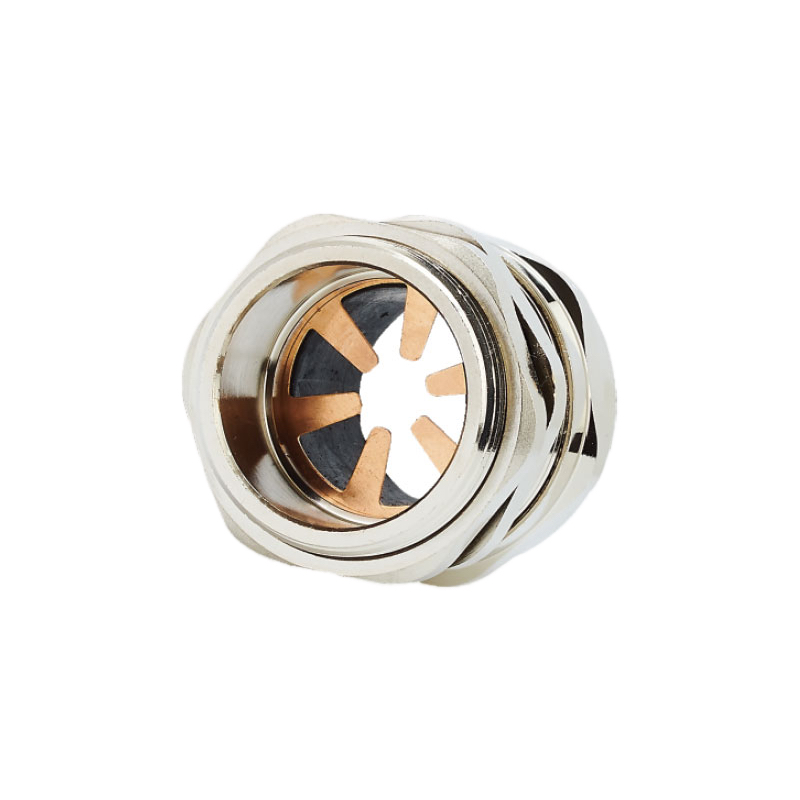Improper cable gland selection for data and coaxial cables causes signal degradation, elektromagnētiskie traucējumi1, and network failures that result in costly downtime, reduced data transmission quality, and compromised system performance, while inadequate shielding and sealing lead to moisture ingress, corrosion, and premature cable failure in critical communication systems. Many engineers struggle with selecting appropriate glands for sensitive data cables, often choosing standard solutions that fail to maintain signal integrity or provide adequate EMC protection.
Selecting the right cable glands for data and coaxial cables requires understanding signal integrity requirements, EMC shielding needs, environmental protection levels, and cable specifications, with EMC cable glands providing 360-degree shielding continuity, proper impedance matching, and environmental sealing to ensure reliable high-frequency signal transmission and electromagnetic compatibility in data communication systems. Success depends on matching gland characteristics to specific cable types and application requirements.
Having worked with network engineers across financial trading floors in London, telecommunications facilities in Seoul, and data centers throughout the Middle East, I’ve learned that proper cable gland selection is critical for maintaining signal quality and system reliability in modern data communication installations. Let me share the essential knowledge for selecting optimal glands for your data and coaxial cable applications.
Satura rādītājs
- What Makes Data and Coaxial Cable Glands Different?
- How Do You Choose EMC Cable Glands for Signal Integrity?
- What Environmental Protection Do Data Cables Need?
- How Do You Ensure Proper Installation and Performance?
- What Are Common Selection Mistakes and Solutions?
- FAQs About Cable Glands for Data and Coaxial Cables
What Makes Data and Coaxial Cable Glands Different?
Data and coaxial cable glands differ from standard power cable glands by providing electromagnetic shielding, maintaining signal integrity, offering precise cable clamping without crushing delicate conductors, and ensuring 360-degree shielding continuity, with specialized designs that accommodate sensitive cable construction while providing environmental protection and EMC compliance for high-frequency signal transmission applications.
Understanding these differences is crucial because data cables have unique requirements that standard cable glands cannot adequately address.
Signāla integritātes prasības
Impedances kontrole: Data and coaxial cables require precise impedance matching2 (typically 50Ω or 75Ω) that must be maintained through the cable gland connection to prevent signal reflections and transmission losses.
High-Frequency Performance: Modern data systems operate at frequencies up to several GHz, requiring cable glands that maintain electrical performance across the entire frequency spectrum without introducing signal distortion.
Low Insertion Loss: Cable glands must minimize signal attenuation, typically maintaining less than 0.1dB insertion loss at operating frequencies to preserve signal strength and quality.
Atgriešanās zudumu optimizācija: Proper impedance matching ensures minimal signal reflection, typically achieving better than -20dB return loss for optimal transmission performance.
EMC Shielding Characteristics
360-Degree Shielding Continuity: EMC cable glands provide complete electromagnetic shielding around the cable entry point, maintaining the cable’s shield integrity and preventing EMI ingress or egress.
Vadošie materiāli: Brass, aluminum, or specialized conductive plastics ensure proper electrical continuity between cable shield and enclosure ground for effective EMC performance.
Ekranēšanas efektivitāte: Quality EMC glands achieve 60-80dB ekranēšanas efektivitāte3 across broad frequency ranges, meeting stringent electromagnetic compatibility requirements.
Ground Connection: Reliable connection between cable shield and equipment ground through the gland body, essential for proper EMC performance and safety.
Cable Construction Considerations
Delicate Conductor Protection: Data cables contain small, fragile conductors that require gentle clamping mechanisms to prevent damage during installation and service.
Dielectric Preservation: Maintaining the cable’s dielectric properties through proper compression without over-tightening that could alter impedance characteristics.
Multi-Cable Accommodation: Many data applications require multiple cables through single entry points, necessitating specialized multi-cable gland designs.
Cable Jacket Compatibility: Different cable jacket materials (PVC, LSZH, plenum-rated) require compatible gland sealing materials and clamping mechanisms.
Specialized Design Features
Sasprindzinājuma mazināšana: Proper strain relief prevents cable damage from vibration, thermal cycling, and mechanical stress without affecting electrical performance.
Vides blīvējums: IP-rated sealing protection while maintaining EMC performance, often requiring specialized gasket materials and designs.
Tool-Free Installation: Many data cable glands feature tool-free installation to simplify field installation and reduce the risk of over-tightening delicate cables.
Modular Construction: Interchangeable components allow customization for different cable types and sizes within the same gland family.
David, a network infrastructure manager at a major financial services firm in Frankfurt, faced recurring network performance issues in their high-frequency trading systems where coaxial cables entered equipment enclosures. The existing standard cable glands were causing signal reflections and EMI problems that affected trading system latency by microseconds – critical in high-frequency trading operations. After analyzing the signal integrity requirements, we specified EMC cable glands with proper 50Ω impedance matching and superior shielding effectiveness. The upgrade eliminated signal reflections, reduced EMI by 40dB, and improved system latency consistency, directly impacting trading performance and profitability. 😊
How Do You Choose EMC Cable Glands for Signal Integrity?
Choosing EMC cable glands for signal integrity requires matching impedance specifications to cable characteristics, selecting appropriate shielding materials and construction, ensuring proper frequency response, and verifying environmental compatibility, with brass or aluminum construction providing optimal conductivity and specialized gasket materials maintaining both EMC performance and environmental sealing for reliable data transmission.
Proper EMC gland selection is critical because even small impedance mismatches or shielding gaps can significantly degrade signal quality in high-frequency applications.
Impedance Matching Requirements
50Ω Systems: Most data communication systems use 50Ω impedance, requiring cable glands designed specifically for this characteristic impedance to prevent signal reflections.
75Ω Applications: Video and some RF applications use 75Ω systems, necessitating glands designed for this impedance to maintain signal integrity.
Impedance Tolerance: Quality EMC glands maintain impedance within ±2Ω of nominal values across the operating frequency range for optimal performance.
Frekvenču diapazons: Impedance matching must be maintained across the entire operating frequency spectrum, from DC to several GHz in modern high-speed data systems.
Shielding Performance Criteria
Shielding Effectiveness Ratings: Select glands with shielding effectiveness appropriate for your EMC requirements, typically 60-80dB for most data applications.
Frekvenču diapazons: Ensure shielding performance covers your operating frequency range, with many modern applications requiring effectiveness up to 6GHz or higher.
Transfer Impedance: Low transfer impedance (typically <1mΩ at 100MHz) ensures minimal coupling between external interference and internal signals.
Shielding Continuity: Verify 360-degree shielding continuity through proper connection between cable shield, gland body, and enclosure ground.

Material Selection for EMC Performance
Brass Construction: Excellent conductivity and corrosion resistance make brass ideal for most EMC applications, providing reliable long-term performance.
Aluminum Options: Superior conductivity and lighter weight, beneficial for applications where weight is critical and corrosion environment is controlled.
Conductive Plastics: Specialized plastic materials with conductive fillers offer corrosion resistance and electrical performance for specific environmental conditions.
Gasket Materials: Conductive gaskets (often silver-filled silicone) maintain both environmental sealing and EMC performance across temperature ranges.
Design Features for Signal Integrity
Low-Profile Designs: Minimize discontinuities in the signal path that could cause reflections or impedance variations affecting signal quality.
Precision Manufacturing: Tight tolerances ensure consistent impedance and reliable electrical performance across production quantities.
Kontaktinformācija Uzticamība: Multiple contact points between cable shield and gland body ensure reliable electrical connection despite thermal cycling and vibration.
Kabeļu atbalsts: Proper cable support prevents mechanical stress that could affect electrical performance or damage delicate data cables.
Selection Matrix for Common Applications
| Lietojumprogrammas veids | Impedance | Frekvenču diapazons | Ieteicamais dziedzeris | Galvenās funkcijas |
|---|---|---|---|---|
| Ethernet/LAN | 50Ω | DC-1GHz | EMC Brass | Multi-cable, IP67 |
| Coaxial RF | 50Ω/75Ω | DC-6GHz | Precision EMC | Low insertion loss |
| Video Systems | 75Ω | DC-3GHz | EMC with gasket | Impedance matched |
| Ātrdarbīgi dati | 50Ω | DC-10GHz | Premium EMC | Ultra-low loss |
| Industrial Comms | 50Ω | DC-100MHz | Ruggedized EMC | Environmental rated |
What Environmental Protection Do Data Cables Need?
Data cables require environmental protection including moisture ingress prevention (IP65/IP67 ratings), temperature stability, UV resistance for outdoor applications, chemical resistance in industrial environments, and vibration protection, with cable glands providing sealed entry points that maintain both environmental protection and signal integrity while accommodating the specific construction and performance requirements of sensitive data transmission cables.
Environmental protection is essential because data cables are often more sensitive to environmental conditions than power cables and require specialized protection strategies.
Moisture and Ingress Protection
Prasības attiecībā uz IP klasifikāciju: Most data cable applications require IP65 or IP67 protection4 to prevent moisture ingress that can cause signal degradation and corrosion.
Sealing Material Selection: Gasket materials must provide reliable sealing while maintaining EMC performance, often requiring conductive elastomers or specialized compounds.
Condensation Prevention: Proper sealing prevents condensation formation inside enclosures that could cause short circuits or corrosion in sensitive electronic equipment.
Long-Term Seal Integrity: Sealing materials must maintain effectiveness throughout the service life despite thermal cycling, UV exposure, and chemical exposure.
Temperatūras apsvērumi
Operating Temperature Range: Data cable glands must function across wide temperature ranges, typically -40°C to +85°C for outdoor applications.
Termiskā izplešanās: Different expansion rates between gland materials, cables, and enclosures must be accommodated without compromising seals or electrical performance.
Temperatūras cikliskums: Repeated thermal cycling can stress sealing materials and electrical connections, requiring robust design and material selection.
Siltuma izkliedēšana: Some high-power data applications generate significant heat that must be dissipated without affecting signal integrity or environmental sealing.
Chemical and Environmental Resistance
Industrial Chemicals: Manufacturing and process environments expose cables to various chemicals that can degrade standard materials, requiring chemical-resistant gland construction.
Izturība pret UV starojumu: Outdoor installations require UV-stable materials to prevent degradation from solar radiation exposure over extended service periods.
Salt Spray Resistance: Marine and coastal applications require corrosion-resistant materials and coatings to withstand salt spray and high humidity conditions.
Cleaning Agents: Food processing and pharmaceutical applications require resistance to aggressive cleaning chemicals and sanitizing agents.
Mehāniskās aizsardzības prasības
Izturība pret vibrācijām: Industrial and mobile applications subject cable glands to continuous vibration that can loosen connections and compromise sealing.
Impact Protection: Robust construction protects against mechanical impact that could damage delicate data cables or compromise environmental sealing.
Kabeļu deformācijas atslogošana: Proper strain relief prevents cable damage from mechanical stress while maintaining electrical performance and environmental protection.
Installation Accessibility: Gland design must allow proper installation and maintenance access while providing required environmental protection levels.
Hassan, who manages operations at a petrochemical complex in Kuwait, needed to upgrade data communication systems in harsh outdoor environments where temperatures reach 55°C and sandstorms create abrasive conditions. The existing cable glands were failing due to seal degradation and corrosion, causing network outages that affected critical process control systems. We specified stainless steel EMC cable glands with high-temperature silicone seals and enhanced corrosion protection. The upgraded glands maintained IP67 protection and EMC performance despite extreme environmental conditions, achieving over 3 years of reliable operation without seal failures or signal degradation issues.
How Do You Ensure Proper Installation and Performance?
Ensuring proper installation and performance requires following manufacturer specifications for torque values, maintaining proper cable preparation techniques, verifying EMC continuity and environmental sealing, conducting performance testing, and implementing regular inspection and maintenance procedures, with proper installation being critical for achieving specified signal integrity, EMC performance, and environmental protection throughout the service life.
Proper installation is often more critical than gland selection because even the best products will fail if incorrectly installed.
Sagatavošana pirms uzstādīšanas
Kabeļu sagatavošana: Proper cable stripping and shield preparation ensures optimal electrical connection and prevents damage to delicate conductors during installation.
Prasības rīkiem: Use appropriate installation tools to achieve proper torque values without over-tightening that could damage cables or compromise performance.
Vides apstākļi: Install under appropriate environmental conditions, avoiding extreme temperatures or moisture that could affect sealing compound cure or gasket performance.
Sastāvdaļu pārbaude: Verify all gland components are present and undamaged before installation, checking gaskets, threads, and electrical continuity.
Uzstādīšanas procedūras
Griezes momenta specifikācijas: Follow manufacturer torque specifications exactly to ensure proper sealing and electrical contact without damaging components or cables.
Shield Connection: Ensure proper connection between cable shield and gland body, often requiring specific techniques for different cable types and shield constructions.
Gasket Positioning: Proper gasket alignment and compression ensures environmental sealing while maintaining EMC performance, requiring careful attention to manufacturer instructions.
Kabeļu maršrutēšana: Maintain proper cable bend radius and avoid sharp edges that could damage cables or affect signal integrity during installation.
Performance Verification
Nepārtrauktības pārbaude: Verify electrical continuity between cable shield and equipment ground through the gland connection using appropriate test equipment.
Impedance Verification: Test impedance matching using time domain reflectometry (TDR)5 or vector network analyzer to ensure proper signal integrity performance.
EMC Testing: Conduct shielding effectiveness measurements if required for critical applications, verifying EMC performance meets specification requirements.
Vides testēšana: Perform leak testing or pressure testing to verify environmental sealing performance meets IP rating requirements.
Kvalitātes kontroles pasākumi
Dokumentācija: Maintain detailed installation records including torque values, test results, and component serial numbers for traceability and maintenance planning.
Inspection Procedures: Implement systematic inspection procedures to verify proper installation before system commissioning and during regular maintenance.
Apmācības prasības: Ensure installation personnel are properly trained on specific requirements for data cable gland installation and testing procedures.
Certification Programs: Consider certification programs for critical installations to ensure consistent installation quality and performance.
Maintenance and Monitoring
Regular Inspections: Establish inspection schedules appropriate for the application environment and criticality, typically annually for most data applications.
Veiktspējas uzraudzība: Monitor signal quality and EMC performance to identify degradation before complete failure occurs in critical communication systems.
Profilaktiskā apkope: Replace gaskets and sealing materials based on manufacturer recommendations or environmental exposure assessment.
Modernizēšanas plānošana: Plan for technology upgrades and changing requirements that may necessitate gland replacement or modification over system lifetime.
What Are Common Selection Mistakes and Solutions?
Common selection mistakes include using standard cable glands for data applications, ignoring impedance matching requirements, inadequate EMC shielding specification, incorrect environmental rating selection, and improper cable compatibility assessment, with solutions requiring systematic analysis of application requirements, proper EMC gland specification, environmental assessment, and comprehensive testing to ensure optimal performance and reliability.
Understanding and avoiding common mistakes is crucial because data cable applications are less forgiving of improper gland selection than power applications.
Technical Specification Errors
Impedance Mismatch: Using glands without proper impedance matching causes signal reflections and degraded performance, requiring specification of impedance-matched EMC glands for data applications.
Inadequate Shielding: Underspecifying shielding effectiveness allows EMI problems that can cause data errors and system failures, necessitating proper EMC analysis and gland selection.
Frequency Range Limitations: Selecting glands with inadequate frequency response for high-speed data applications, requiring verification of performance across the entire operating spectrum.
Cable Compatibility Issues: Mismatching gland designs with specific cable constructions, particularly with armored or specialty data cables requiring compatible gland designs.
Environmental Assessment Oversights
IP Rating Inadequacy: Underspecifying environmental protection leads to moisture ingress and system failures, requiring proper environmental analysis and appropriate IP rating selection.
Temperature Range Errors: Ignoring temperature extremes that exceed gland ratings, particularly in outdoor or industrial applications with wide temperature variations.
Ķīmiskā savietojamība: Failing to consider chemical exposure that can degrade gland materials, requiring assessment of cleaning agents, process chemicals, and environmental contaminants.
UV Exposure Neglect: Outdoor installations without UV-resistant materials experience premature degradation, necessitating UV-stable material selection.
Installation and Application Mistakes
Over-Tightening: Excessive installation torque damages delicate data cables and compromises performance, requiring proper torque specifications and installation procedures.
Slikta kabeļu sagatavošana: Inadequate cable shield preparation prevents proper EMC performance, necessitating proper training and installation procedures.
Neatbilstoša testēšana: Skipping performance verification allows undetected problems that cause later failures, requiring comprehensive testing protocols.
Apkopes nolaidība: Failing to establish proper maintenance procedures leads to gradual performance degradation and unexpected failures.
Cost-Based Decision Errors
Viltus ekonomija: Selecting low-cost glands that fail prematurely or perform inadequately, requiring lifecycle cost analysis rather than initial cost comparison.
Pārmērīga specifikācija: Specifying excessive performance requirements that increase costs without benefit, requiring balanced analysis of actual application needs.
Standardization Issues: Using single gland types for all applications without considering specific requirements, necessitating application-specific selection strategies.
Maintenance Cost Neglect: Ignoring long-term maintenance and replacement costs in selection decisions, requiring total cost of ownership analysis.
Profilakses stratēģijas
Systematic Analysis: Develop comprehensive application analysis procedures that consider all technical, environmental, and economic factors in gland selection.
Specification Templates: Create standardized specification templates for different application types to ensure consistent and complete requirement definition.
Supplier Collaboration: Work closely with qualified suppliers who understand data cable applications and can provide proper technical support and guidance.
Testing Programs: Implement systematic testing and validation procedures to verify performance before full deployment in critical applications.
Secinājums
Selecting the right cable glands for data and coaxial cables requires understanding the unique requirements of signal integrity, EMC performance, and environmental protection that distinguish these applications from standard power cable installations. Success depends on proper technical specification, environmental analysis, and installation procedures.
The key to reliable data cable gland performance lies in matching EMC characteristics to application requirements, ensuring proper environmental protection, and implementing systematic installation and maintenance procedures. At Bepto, we specialize in EMC cable glands designed specifically for data and coaxial cable applications, providing the technical expertise and quality products needed to ensure optimal signal integrity and system reliability in your critical communication installations.
FAQs About Cable Glands for Data and Coaxial Cables
J: Kāda ir atšķirība starp EMC kabeļu uzmavas un parastajām kabeļu uzmavas?
A: EMC cable glands provide electromagnetic shielding and impedance matching while regular glands only offer basic sealing. EMC glands include conductive materials, 360-degree shielding continuity, and precise impedance control essential for data signal integrity.
Q: How do I choose the right size EMC cable gland for my data cables?
A: Measure your cable outer diameter and select a gland with appropriate clamping range, typically allowing 10-15% tolerance. Verify thread size compatibility with your enclosure and ensure the gland’s impedance matches your cable system (50Ω or 75Ω).
Q: Can I use standard cable glands for low-speed data applications?
A: Standard glands may work for very low-speed applications (below 10MHz) but EMC glands are recommended for any data application requiring signal integrity or EMC compliance. Even low-speed systems benefit from proper shielding and impedance matching.
Q: What IP rating do I need for outdoor data cable installations?
A: Outdoor data cable installations typically require IP65 minimum, with IP67 preferred for harsh environments. Consider temperature range, UV exposure, and chemical resistance requirements when selecting environmental protection levels.
Q: How often should I inspect EMC cable glands in data systems?
A: Inspect EMC cable glands annually for most applications, quarterly for critical systems, and immediately after environmental events. Monitor signal quality continuously where possible to detect performance degradation before complete failure.
-
Learn the fundamentals of EMI and how it can disrupt electronic devices and signals. ↩
-
Explore a technical guide on why impedance matching is critical for preventing signal reflection. ↩
-
Understand how shielding effectiveness is measured and what the decibel (dB) ratings signify. ↩
-
See a detailed chart explaining the levels of protection against dust and water for each IP rating. ↩
-
Discover the principles behind TDR and how it’s used to find faults in cables. ↩




